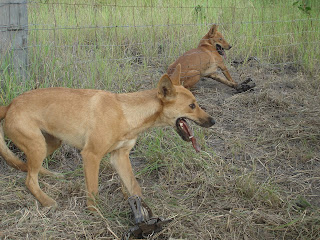...with
Ted Mitchell
SO, you are thinking of trying your hand at
trapping? Well, I highly recommend it as not only a very useful tool for
predator control work, but also as a great way to spend some leisurely time in
the fresh air. But first, you will have to figure out what traps you will need.
 |
| Two at a time. |
Foothold traps come in many different sizes. These can
vary in size from # 1 sized traps often used for rabbits, #1 ½ size traps for
cats and fox, #2 size traps can be an intermediate trap, used for cats and
foxes, and also for wild dogs/dingoes. #3 size and up to #5 are mainly used for
wild dogs. Traps also come in different shapes and styles. They can be ‘long
spring’ traps with single or double springs, or ‘coil spring’ traps, with
either two coils or four. Some are ‘dog on’, and some are ‘dogless’.
As you can see, it is not always an easy
decision for the beginner. So first things first. What is your main target
animal? Wild dog, fox, or cat? Of course, if your target animal is one of the smaller
animals, then a #1 ½ size trap will suffice. If you think you may want to one
day move up to wild dogs, then may I suggest you go straight to a #3 sized
trap, as the larger dimensions in both jaw width and pan size will make catches
a little easier on the smaller critters anyway. The only real downside to this
is that the actual larger size of the trap will sometimes make it a little
harder to get it into a tighter spot.
Personally, I like the ‘coil spring’
models, and would always recommend the same to anyone wanting to buy their
first traps. They are much more compact than the ‘long spring’ models, and are
generally easier to set too.
 |
| A Jake trap by J.C. Connor, a great 'dogless' design |
Next time we will look at chain systems.
.jpg)
No comments:
Post a Comment
Feel free to tell us what you think. We love to talk hunting...